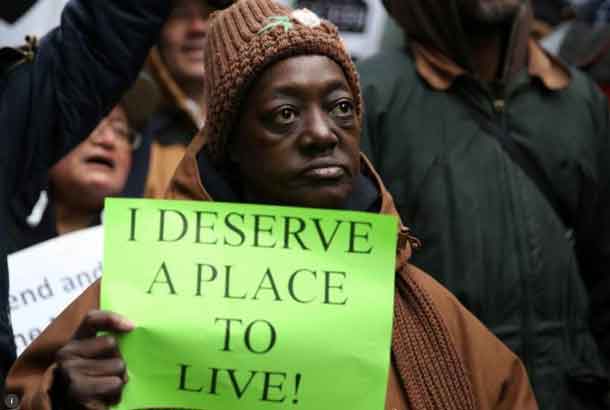

“Within two weeks, I had a place to stay”
By Carey L. Biron
WASHINGTON – (Thomson Reuters Foundation) – The past couple of years have been a roller-coaster for Maurice Cushinberry – first of homelessness, substance abuse and legal trouble, and then of sudden stability.
Although he had tried to find a home during that time, he was discouraged by the paperwork and process. But shortly after Easter last year, a social worker contacted him and said he had been selected to participate in a new housing programme.
“Within two weeks, I had a place to stay,” Cushinberry told the Thomson Reuters Foundation from Denver. “They gave me housing first, and then we tried to work out all the other kinks in my life.”
The programme is one of a rising number of initiatives around the world bringing together government departments, service providers, foundations, banks, pension funds and more to address complex social problems.
The key innovation is how they these programmes are financed.
Rather than rely on handouts by cash-strapped governments, private investors step in to provide money through a financing tool known as a social impact bond.
The investors – most of them philanthropic organisations and entrepreneurs – provide upfront capital to deliver social services and only get a return if the programme achieves predefined results.
The approach, also known as “pay for success”, is motivated by a simple set of questions: how can public services ensure they are accomplishing what they set out to achieve, and can prove they are effective to prompt more investment?
GLOBAL IMPACT
Since 2010, the idea has started catching on across the globe. This week, the Social Finance Global Network announced 108 social impact bonds are now in existence, in 24 countries.
“Because it’s so complicated and involves so many sectors, bringing these uncommon partners around a common goal, I would never have projected how swiftly it went from concept to reality,” said Tracy Palandjian, co-founder of the U.S. arm of Social Finance, a London-based pioneer on the issue.
Social Finance UK spearheaded the world’s first social impact bond in 2010, raising 5 million pounds ($7 million) for a programme aimed at reducing reoffending among former inmates of Peterborough prison in England.
Dozens of such initiatives addressing issues such as housing and low-income health care have since been launched globally, according to Social Finance, raising almost $400 million and affecting more than 700,000 people.
Social Finance said out of the 27 social impact bonds that have been completed, 10 have been successful enough to return a full investment.
Last year saw 32 new launches in nine countries, and others have been announced over the past month.
BREAKING THE CYCLE
While many social impact bonds have originated at the national and state levels, homelessness is an issue typically addressed directly by cities.
Globally, housing issues make up the third-largest area for social impact bonds, according to a Social Finance database.
“What’s interesting about cities is they’re much more agile in terms of decision-making. They concentrate on improving their communities using their own budgets,” said Ronald Cohen, chair of a global steering group on social impact investing and a prominent supporter of the bonds.
Tackling social problems can often be more manageable at the urban scale, Cohen noted, and cities are notable in their ability to get local communities involved in a social project.
“A lot of mayors are interested in social impact bonds,” he said.
One example is Denver, where an $8.6 million, five-year project began in 2016 with the aim of providing 250 long-term homeless people who made frequent use of the emergency services with affordable housing, as well as health care and other services.
Maurice Cushinberry is one of the participants.
This past month the project met its participants’ quota and is now fully up and running.
Although the Denver project is the third in the United States to focus on homelessness, it is the first to combine this with a focus on breaking what organizers call the “homelessness-jail cycle”.
Social spending on those 250 people would typically amount to around $7.3 million per year – “extremely costly and ineffective”, according to a fact sheet by the city.
Under the social impact bond, Denver agreed to pay the eight local and national foundations and funds that invested a certain rate — a bit over $15 — for each day the 250 participants are stably housed and not in jail, up to around $11.4 million.
Through the project’s first 18 months, it surpassed agreed benchmarks.
“They’re getting and staying housed – this was a really positive first look,” said Sarah Gillespie, a senior research associate with the Urban Institute, a think tank, and lead author on a report tracking the project’s first year and a half.
After a year, the research found, 89 percent of the first 100 participants were still in stable housing. That means the city’s first payment to investors will total around $188,000, according to the mayor’s office.
Calculations and any payments on jail time will come only after three years of full data, although expectations are for a reduction of 35 to 40 percent.
Buoyed by these initial results, Denver Mayor Michael Hancock has requested additional funds this year to expand the programme by another 100 participants.
MEASURING IMPACT
Social impact bonds have been criticized for the lengthy timeframes required for implementation, the complexity of establishing the contract and the rigour of data analysis required.
But supporters say the approach is fundamentally changing the way that government works.
“Government has never really measured the impact of its expenditures,” said Cohen, but it is “beginning to realize that in its commissioning, it can do a lot better.”
In Denver, Cushinberry knows all about impact. He now has a job at a thrift store, an apartment near his family — and something he hadn’t known for a long time.
“There is security and certainty,” he said. “In my life on the streets, I didn’t have that.”
($1 = 0.7055 pounds)
Reporting by Carey L. Biron, Editing by Astrid Zweynert @azweynert.; Credit the Thomson Reuters Foundation




